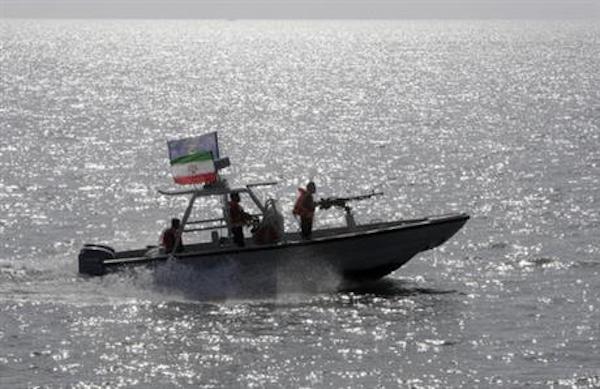On April 24, 2004 the USS Firebolt, a Cyclone-class coastal patrol boat in the Persian Gulf, launched a rigid-hulled inflatable boat (RIB) when its crew observed a dhow — a traditional boat, in this case likely owned by Iran — fast approaching the Al Amaya oil terminal in Iraq. Suspecting an attempt to destroy the terminal, the RIB’s seven-man crew pulled alongside the Dhow in order to board it. The dhow blew up in a blast intended for the terminal. Two sailors, Navy Petty Officers Michael Pernaselli and Christopher Watts, were killed instantly. Coast Guard Petty Officer Nathan Brukenthal died when the RIB turned over in the water. Brukenthal was the first Coast Guardsman killed in action since the Vietnam War.
Last week, the USS Firebolt was back in the news.
On September 4th a swarm of seven Iranian fast boats, armed with guns and missiles and belonging to the Iranian Revolutionary Guard naval force, harassed the Firebolt and forced it to divert from its heading to avoid a collision. In an incident that lasted some eight minutes, three of the Iranian boats maneuvered within about 500 yards of the Firebolt and then pulled away. Another Iranian boat sped in front of theFirebolt and blocked its path. From what can be ascertained, the Firebolt sent radio warnings that were not answered and then -– closing in at about 100 yards -– the Firebolt turned away to avoid the “parked” Iranian attack craft. The Firebolt did not fire warning shots or blast its foghorn.
The Iranians were once again clearly testing swarm boat techniques and seeking to provoke the United States. It was the fourth time in less than a month. American official said there have been 31 similar events this year, almost double the same period last year. This incident follows other recent harassment of vessels including the guided missile destroyer Nitze, the patrol ships Tempest and Squall and the destroyer, the USS Stout.
General Joseph Votel, commander, U.S. Central Command, said the Iranians are conducting “unsafe maneuvers” to exert their influence in the Gulf. He is correct.
There are major political, psychological, and military gains for the Iranians from these provocations.
On the military level the Iranians are learning a lot about the speed of the U.S. Command Structure –- how long it takes for a warning to be made and what happens when the first radio broadcast, foghorn, or gun is fired. One can imagine the Iranians with stopwatches. A successful swarm attack that can do real damage to major U.S. naval assets needs to be correctly sequenced, as the Iranians surely know. Even though U.S. warships are poorly equipped to deal with swarming fast attack boats, they are not without resources. And air power can be called in to augment U.S. ships under attack. If Iran’s objective in such a situation involving a real attack is to cause serious damage to a U.S. aircraft carrier or a guided missile cruiser, by now they know pretty much what they have to do and what price they will pay.
The sight of U.S. warships running away from Iranian fast boats is great political propaganda that, for the Iranians, plays well at home and abroad. It is the perfect David and Goliath moment in which the Great Satan is forced to turn and run. Iran, in fact, made a video purporting to show the sinking of the Nitze as a result of Iranian “courage and righteous anger” at an “American invasion.” Internally, such propaganda boosts the Revolutionary Guard, increasing its leverage. Outside, it helps Iran spread its influence in the region and as far afield as South America.
American allies and clients in the Persian Gulf and Middle East feel the opposite impact. If the United States does not stand up to aggression, smaller and less capable countries may find it necessary to accommodate Iran. President Obama and American policy compound their distress. The president told Jeffrey Goldberg in an Atlantic magazine interview that Saudi Arabia — a U.S. ally and Iranian adversary — “needs to find an effective way to share the neighborhood and institute some sort of cold peace.” Reflexively backing the Saudis against Iran, he said, “would mean we have to start coming in and using our military power to settle scores. And that would be in the interest neither of the United States nor of the Middle East.”
The president quickly eschews the idea of military force in the Gulf, but what other response is there to the problem posed by Iranian-created incidents? The Iranians have already captured American sailors, and it is only a matter of time before an American is killed by Iranian action — on purpose or in error.
To stop an evolving and increasingly dangerous game, the United States has to take aggressive action against Iranian fast attack boats before they come after us. The goal is not to start a war — the Iranians are already working on that — but low passes by fighter planes or helicopter gunships, rapid firing guns, and aggressive chase will make it clear to the Iranians “this far and no farther.”
The U.S. must not be chased out of international waters. The U.S. Navy surely has the assets to do the job. We just need courage from our politicians.


